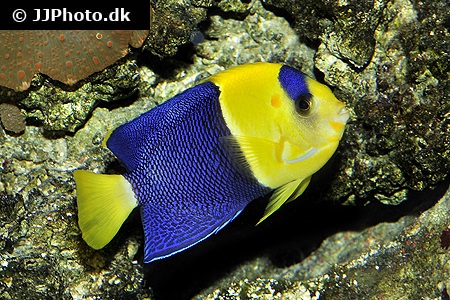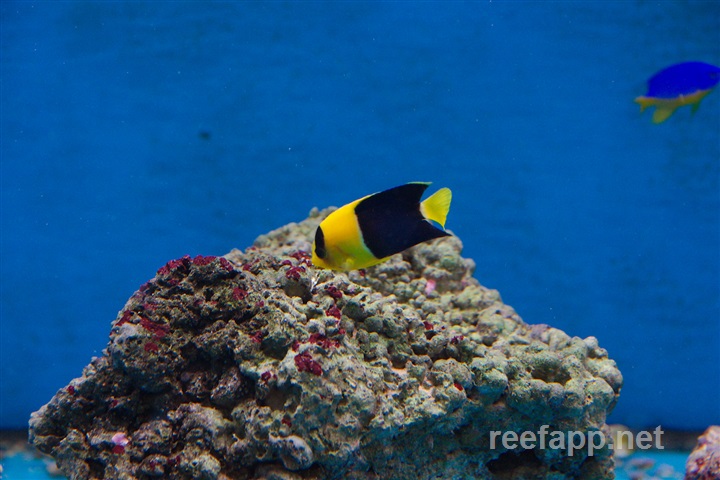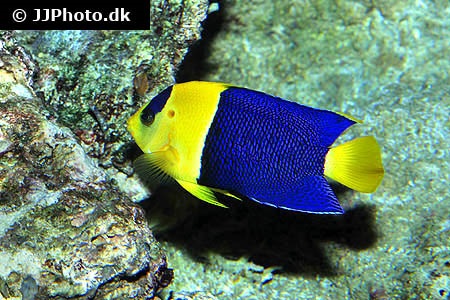Centropyge bicolor
| Latin name | Centropyge bicolor - (Bloch, 1787) |
|---|---|
| Local name | Bicolor Angelfish |
| Family | Pomacanthidae - Centropyge |
| Origin | East Indian Ocean, West Indian Ocean, Australia, Indonesia |
| Max length | 15 cm (5.9") |
| Minimum volume |
300 l (79 gal) |
|---|---|
| Hardiness |
Average |
| Suitable for aquarium |
Suitable with care |
| Reef safe |
Not reef safe |
| Aggressiveness | Mostly peaceful but might be aggressive towards similar species |
| Recommended |
Microalgea (Eg. spirulina) |
|---|---|
| Mostly |
Large polyp stone coral (LPS) Small crustaceans (Krill, mysis, artemia...) Soft coral Zooplankton (Cyclops, pods...) |
| Maybee |
Macroalgea (Eg. seaweed / nori) Other invertebrates |
This species likes to eat tubeworms.
This species is known to eat the polyps of various corals.
This species sometimes nibbles at clams including Tridacna species.
These fish should be kept in a well run aquarium where they can "graze" algae from rocks and stones.
If there are insufficient algae on the rocks, it is important to feed more frequently and supplement with algae rich food e.g. Spirulina.
This species requires places to hide, especially when newly introduced into the aquarium.
This species can change gender from female to male.
When a male is needed, a female changes sex and takes on the role.
It can be a challenge to keep corals together with Angelfish, since the latter eat most soft corals and LPS. Especially Zoathus are swiftly eaten by the larger species.
It is however possible to build up a mixed coral aquarium with Angelfish. If some of the following corals are choosen there is a good chance the Angelfish will leave them alone; Hammer corals, Bubble corals, Star polyps, Disc anemones and others.
Most of the SPS corals can be kept with Angelfish.
It is possible to keep various different sizes of Angelfish in the same aquarium, but it means that one must choose species with care and that the conditions in the tank are optimum.
Here are some suggestions to increase the chances of success:
Choice of species
It is important not to choose species that are too similar, the greater the variance, the larger the chance of success. It is also advantageous to choose fish of different sizes. Two young Angelfish of the same same size and pattern for example are a bad idea. One should of course avoid the most aggressive species.
Order of introduction
It is a good idea to make a wishlist and choosing the order so, that the least aggressive are introduced first. When adding similar sized Ange fish it works best if they are introduced simultaneously.
Space
There should be enough space in the aquarium, but it is difficult to give specific advice. Of course there are exceptions to the table below as to just how big a tank should be in order to stand a good chance of success. Space itself is not enough, there should also be sufficient hiding places so the fish do not have to fight over these.
100 gal (400 liters): Several small Angelfish (<15cm) can live together.
240 gal (900 liters): Several medium Angelfish (< 20cm) can live together.
400 gal (1500 liters): Several large Angelfish (<25cm) can live together.
Food and water quality
It is always helpful to give the fish a varied diet, so they can withstand the occasional stress situation when for example new fish are introduced. Water quality must also be very high, so that the fish do not get stressed for that reason either.
Centropyge and Paracentropyge (Dwarf Angelfish) are some of the most colourful fish on the reef.
They are popular for aquaria as they do not become so large as other Angelfish species. They grow typically to about 10 cm, but some up to about 18 cm.
They are not normally reef safe. But there are species, with which there is a reasonable chance of success. Most will not eat the coral polyps but will go after the coral produced mucus. This can disturb some LPS, Zoanthus and clams so much so that they will die from it.
It is hard to predict if a species is reef safe, as there is always a risk when adding Dwarf Angelfish to a reef aquarium.
They live normally on microalgae and detritus. Some species for example. C. loriculus and C. flavissima also eat microalgae as well as green hair algae as part of their diet. Food which includes Spirulina, nori and fresh vegetable matter, are perfect for Dwarf Angelfish.
A. tristis and A. poyroferus closely resemble several species of Angelfish, but they lack the spine on each side of the head.
Angelfish (Pomacanthidae) are known as some of the most colourful and impressive fish on the reef.
Many species are not reef safe, as they especially target the soft corals and LPS. But by choosing your corals carefully, or by getting specific species of Angelfish, they can be kept in coral aquariums.
There are Angelfish suitable for most aquarium sizes, from Dwarf Angelfish which are well suited to smaller aquaria, to the larger of the species which can be impressively displayed in a larger aquarium.
The demands of the individual species can vary widely. Some are food specialists and require therefore special food, while for others can be difficult to acclimatize, as they live in deep water in the wild. It is recommended that one has a reasonably good knowledge of the different types of food and of treatments of illnesses, if one wishes to keep the larger species.
| Aquarium trade | Yes |
|---|---|
| Distribution | Indo-Pacific: East Africa to the Samoan and Phoenix Islands, north to southern Japan, south to New Caledonia; throughout Micronesia. |
| Danish common names |
Tofarvet dværgkejserfisk Tofarvet Dværgkejser |
| English common names |
Bicolor angelfish |
| French common names |
Poisson-ange bicolore |
Henry C. Schultz. 2003. What a Darling Little Angel: The Genus Centropyge - Reefkeeping Magazine - (English)
James Fatherree. 2007. The Pygmy Angelfishes - Reefkeeping Magazine - (English)
Niels K. 2014. Private conversation - saltvandsforum.dk - (Danish)
Scott W. Michael. 2004. Angelfishes and Butterflyfishes (Reef Fishes Series Book 3) TFH Publications / Microcosm Ltd. - (English)
Bob Fenner. Marine Angelfishes, Family Pomacanthidae - Wet Web Media - (English)
Bob Fenner. The Best Angelfishes For Marine Aquarium Use - Wet Web Media - (English)
Bob Fenner. The Ultimate Angelfish Aquarium; An amazing and challenging collection of marine angelfishes - Wet Web Media - (English)
Collection of links to additional information - Wet Web Media - (English)
Reef Central. 2009. Keeping more than one emperor angelfish together - (English)




